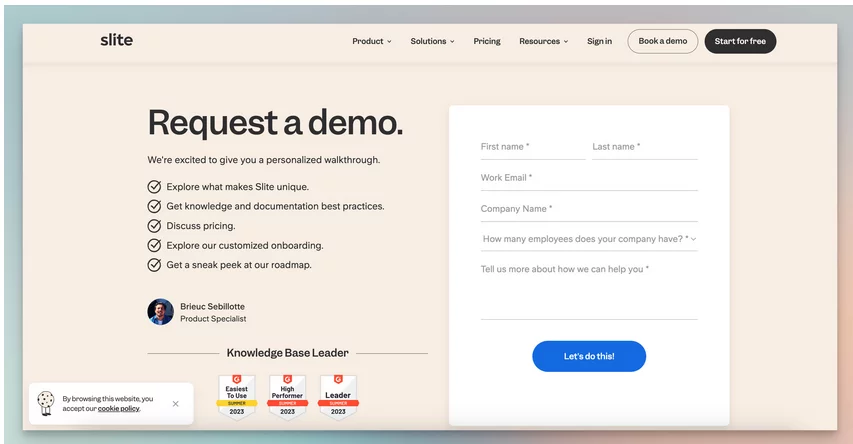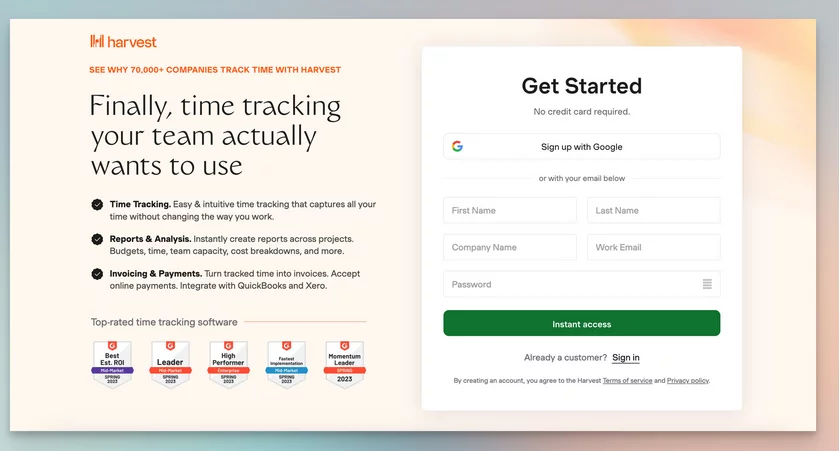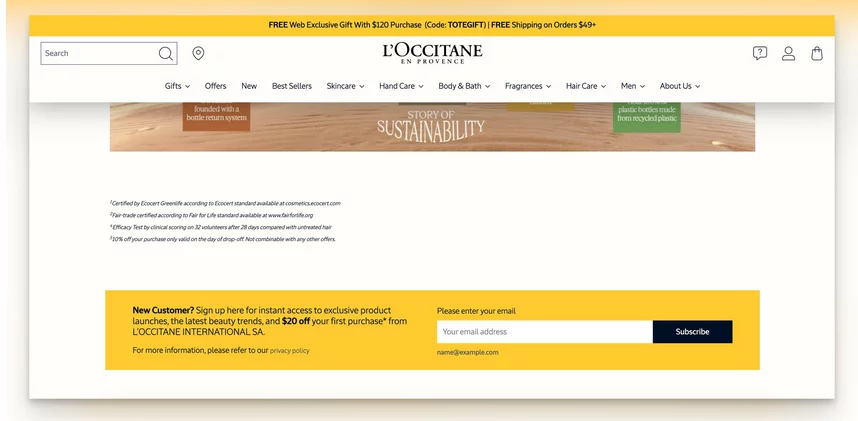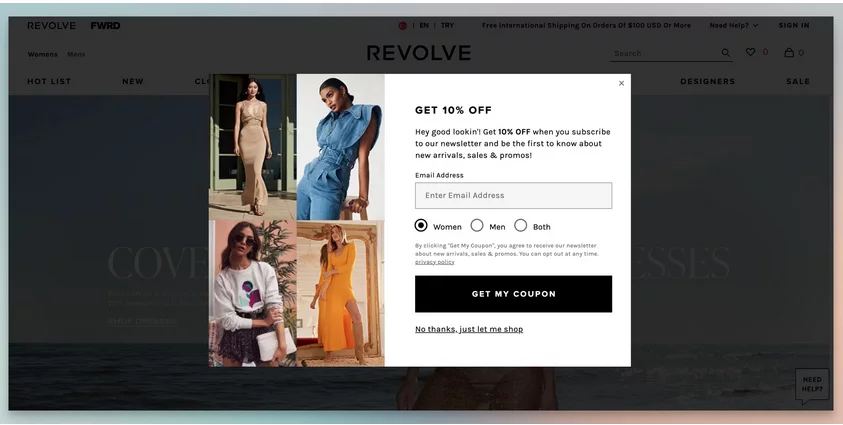Lead generation forms play a pivotal role in modern marketing strategies, serving as bridges between businesses and their potential customers. These forms act as information gateways, allowing businesses to capture valuable data about their target audience, including contact details, preferences, and needs. With this data in hand, businesses can create tailored marketing campaigns, enhance user experiences, and build strong customer relationships.

- Collecting Audience Information: Lead generation forms act as powerful data-capturing tools, allowing businesses to collect valuable information about their target audience. By strategically designing these forms, businesses can ask relevant questions and obtain crucial details, such as names, email addresses, demographics, interests, and more. This data provides valuable insights into customer preferences and behavior, helping businesses understand their audience better and tailor their marketing strategies accordingly.
- Building an Engaged Email List: One of the primary goals of lead generation forms is to build a high-quality email list. When visitors submit their information through these forms, they provide explicit consent to receive communications from the business. This opens up a direct line of communication through email marketing, which remains a highly effective and personalized channel for engaging with potential customers. By sending relevant content, promotions, and updates via email, businesses can nurture leads, build brand loyalty, and encourage repeat business.
- Personalization and Enhanced User Experience: Lead generation forms offer businesses the opportunity to gather data about their audience’s preferences, needs, and pain points. Armed with this knowledge, businesses can create personalized experiences for their leads, tailoring their marketing messages to address individual needs. Personalization not only enhances the user experience but also establishes a stronger emotional connection between the business and its customers, increasing the likelihood of conversion and customer retention.
- Effective Lead Segmentation and Targeting: Lead generation forms allow businesses to segment their leads based on their responses. By categorizing leads into different groups or segments, businesses can create targeted marketing campaigns that resonate with specific audiences. This approach ensures that the right message reaches the right people at the right time, increasing the effectiveness of marketing efforts and driving higher conversion rates.
- Boosting Conversion Rates and ROI: Well-optimized lead generation forms can significantly improve conversion rates. By designing user-friendly and intuitive forms, businesses reduce the chances of form abandonment and increase the likelihood of successful submissions. As a result, businesses can capture more leads and convert a higher percentage of website visitors into potential customers. A higher conversion rate directly translates into a more cost-effective lead generation process, ultimately leading to a higher return on investment (ROI) for marketing efforts.
Examples of Successful Lead Generation:
1. Slack‘s Contact Sales Team Form: Lead Generation Done Right

Slack’s contact sales team form sets a stellar standard for lead generation forms. The page welcomes users with a warm message, “We’re happy to answer questions,” creating a friendly atmosphere from the start.
Bullet points list possible questions and topics that the sales team can address, ensuring users feel well-informed about the form’s purpose. In addition to gathering contact details, the form intelligently includes company and sales-oriented questions to provide a comprehensive understanding of potential clients’ needs.
An intriguing aspect of this lead generation form is the “Anything else?” field, which cleverly asks, “What challenges are you looking to overcome with Slack?” This indicates that the company values its audience’s pain points and seeks to address them effectively. To boost engagement, the form showcases the “Incredible companies use Slack” section, highlighting renowned brands like Airbnb and Uber. This emphasis on social proof reinforces the credibility of Slack for prospective users.
Furthermore, a compelling testimonial from Lyft’s Vice President of Sales adds another layer of interest to the page, showcasing satisfied customers and their positive experiences with Slack. This personal touch enhances the overall appeal of the lead generation form, making it an excellent example for other businesses to follow.
In addition to the aforementioned questions, the lead generation form also includes contact information for the sales team, encouraging users to make phone calls for more personalized assistance. Upon completing the form, the brand analyzes the provided answers to suggest the most suitable plan for the user and provides further details about the recommended plan.
Once the form is submitted, users are directed to the sign-up page, where they have the opportunity to convert from prospects to valued customers. This seamless transition from the lead generation form to the sign-up page ensures a smooth user experience and maximizes the chances of successful customer acquisition.
2. Mailchimp‘s Quiz Form for Tailored Plan Selection: Simplifying Choice

Mailchimp’s pricing page boasts a well-placed section titled “Not sure which plan is for you?” enticing users to take a quiz and discover their ideal plan through the CTA “Find my plan.” This strategic placement on the pricing page caters to potential customers who seek clarification, and offering them a quiz to identify a suitable plan simplifies their decision-making process. The lead generation quiz, designed by Mailchimp, commences with the question “What are your main marketing goals?” and continues with relevant inquiries about potential customer goals, company size, and specific use cases.
Each answer choice for a question is accompanied by informative details, and beneath the questions lies a section titled “Why we are asking,” which elucidates the purpose of collecting specific data and posing particular questions. This approach is an excellent example of how to transparently inform visitors about data collection while simultaneously engaging them.
Furthermore, the quiz form thoughtfully includes the contact information of the sales team, encouraging users to reach out for personalized assistance via phone calls. By doing so, Mailchimp ensures potential customers receive the necessary support during their decision-making process.
Upon completion of the quiz, the brand analyzes the provided answers and presents users with the most suitable plan based on their responses, complete with details about the recommended plan. The culmination of the lead generation process directs users to the sign-up page, allowing them to seamlessly convert from prospects into valuable customers. This smooth transition from the quiz to the sign-up page optimizes the user experience, increasing the likelihood of successful customer acquisition for Mailchimp.
3. Slite’s Book a Demo Form with Trust Badges: Bridging Trust and Interaction

Slite’s captivating “Request a demo” form immediately catches the eye with its headline and presents the benefits of a demo through concise bullet points, making it easy for users to understand what they can expect. Adding a human touch, the form showcases the name, photo, and title of an employee, a thoughtful touch that establishes a sense of connection and authenticity. Incorporating real people from the company or customers in the form enhances sincerity and engagement, ultimately fostering trust with potential leads.
At the top of the funnel, Slite strategically showcases its achievements as the easiest, high performer, and leading company with G2 trust badges on the demo page. These trust badges play a pivotal role in lead generation forms, instilling confidence in visitors and increasing their interest in the company’s offerings.
The form’s layout places the short and to-the-point fields on the right side of the page, efficiently gathering contact and company details while also providing a long text input to collect additional questions from visitors. This comprehensive approach ensures Slite can understand its leads’ needs and preferences, enhancing the quality of interactions.
The form concludes with an engaging and personalized submit button that exclaims, “Let’s do this!” This cleverly crafted CTA button exemplifies how injecting a personal touch into such buttons can make the lead generation form more compelling. Rather than using a mundane “Submit” button, Slite opts for a warm and sincere approach that encourages users to take the next step with enthusiasm and confidence.
4. Zendesk‘s Quick Quiz for Demo Viewing: Navigating User Experience

Duolingo, the language learning platform, streamlines the onboarding process with a thoughtfully designed multi-step lead generation form.
In the initial step, Duolingo inquires, “How did you hear about Duolingo?” This clever query allows the platform to gain insights into its target audience’s discovery channels, enabling them to make necessary improvements and enhance their marketing strategies. The subsequent questions revolve around language learning, such as “Why are you learning a language?” This approach provides Duolingo with valuable information about the aims and use cases of their audience, allowing for a tailored learning experience.
Another essential question, “Choose your daily goal,” reminds users to set their daily learning objectives, promoting consistent engagement with the platform.

As the form progresses, Duolingo inquires about users’ language proficiency, prompting them to indicate whether they are just starting their language journey or already have a target language in mind.
To deliver a personalized experience, the form includes a language assessment test, allowing visitors to gauge their language proficiency and set suitable learning goals. By utilizing this lead generation form example, Duolingo adeptly provides users with a customized learning path without immediately requiring email addresses or sign-ups. The form’s insightful questions cater to language learning needs, making it a valuable tool in the onboarding process.
5. Harvest’s Sign-Up Form with Features & Social Proof: Captivating the Audience

Harvest, a leading time-tracking software, has designed its sign-up form to highlight its top features, making it engaging and attention-grabbing. The form is concise, consisting of three bullet points showcasing the tool’s standout capabilities. Adding a touch of social proof, the page proudly announces that over 70,000 companies rely on Harvest for time tracking, reinforcing the tool’s credibility and popularity. Incorporating G2 trust badges below the top features further emphasizes Harvest’s status as a high-performing solution, instilling confidence in potential users.
The sign-up form, positioned on the right-hand side of the page, commences with a straightforward “Get Started” headline. To streamline the sign-up process, users are offered the option to sign up with Google, ensuring a smooth and seamless experience. The form inputs are designed to be simple and minimal, ensuring a quick and easy sign-up process. The form culminates with an inviting “Instant Access” submit button, underscoring the tool’s swift setup process.
Employing a sign-up page with a lead generation form like this is a critical step that should not be underestimated. By showcasing top features, trust badges, and social proof of its extensive customer base, Harvest effectively attracts new customers and users, making it a powerful tool for conversion.
6. Warby Parker‘s Quiz for Product Recommendation: Interactive Engagement

Warby Parker, a renowned glasses brand, offers an interactive product recommendation quiz to help people find their perfect frames. The quiz is prominently displayed on the brand’s homepage, serving as an engaging multi-step lead generation form.
Comprising eight thoughtfully crafted questions, the quiz covers various aspects such as style preferences, face width, glasses shapes, favorite colors, glasses materials, and the time of the last eye exam. One interesting feature of the quiz is its question about whether users also want sunglasses recommendations. This cleverly upsells different products to those searching for glasses, effectively promoting other relevant items and maximizing conversion opportunities.

In the final step of the quiz, visitors are asked whether they wish to save their results for later, and an “Email” form field is included. By incentivizing users to provide their email addresses, Warby Parker entices them with exclusive access to new frames, events, and more through their email newsletter. The option to skip this step is also available, but regardless of the choice, Warby Parker concludes the quiz by recommending suitable products based on the quiz answers.

The inclusion of an email collection option on the lead generation form is a smart move for growing their email list and nurturing customer relationships through personalized content and offers. While some may choose to forgo this option for a more direct email collection approach, Warby Parker skillfully strikes a balance by still providing product recommendations for potential sales.
7. Alex and Ani’s‘s Gamification Popup with a Discount: Playful Conversion

Alex and Ani’s ingenious use of a gamification popup, enticingly combined with a discount offer, is a brilliant strategy to captivate their audience and drive lead generation. Their spin-to-win popup instantly catches the user’s attention with an exciting headline that reads, “Spin for a chance to win,” followed by an enticing list of potential prizes. The alluring “Spin Now” call-to-action button beckons users to engage in the interactive experience.
Once the wheel is spun, a second popup reveals the reward, creating a sense of anticipation and excitement. Users are pleasantly surprised to find out that they’ve won a tempting 20% discount, but there’s one small favor to ask – their email address.
This masterstroke combines the thrill of winning with the added benefit of a special discount, enticing visitors to willingly share their email addresses. Not only does this lead to an impressive growth in the brand’s email list, but it also increases the likelihood of converting those leads into customers, as they’re eager to utilize their well-earned coupon code.

Alex and Ani’s attention to detail is evident in the second step of the popup, where a clear product image, consistent font, and the brand’s logo create a cohesive and visually appealing experience. This strategic design aligns perfectly with the brand’s identity, ensuring a seamless and memorable interaction with their audience.
By incorporating gamification into their e-commerce popup, Alex and Ani have ingeniously engaged their website visitors in a fun and interactive manner. Such innovative approaches foster a positive user experience, leaving a lasting impression on potential customers and ultimately driving sales and brand loyalty.
8. e.l.f. Cosmetics’‘ Exit-Intent Form with a $5 Off: Retaining Attention

e.l.f. Cosmetics, the renowned cosmetics brand, employs a clever exit-intent lead generation form popup to gracefully capture the attention of visitors contemplating leaving their website.
Upon activation, this eye-catching popup immediately seizes the user’s focus with vibrant product images, invoking curiosity and interest. The compelling headline reads, “Wait! Don’t Go,” effectively urging users to pause and reconsider their decision to leave.
To sweeten the deal, e.l.f. Cosmetics offers an enticing $5 discount to entice visitors to sign up for their email newsletter. The value of the offer is succinctly communicated in a brief and compelling description, ensuring clarity and instant appeal. The form popup concludes with a witty and on-brand call-to-action button, playfully dubbed “E.L.F YEAH!” This distinctive touch exemplifies the brand’s personality, resonating with their target audience and fostering a positive brand perception.
Keeping the style minimal and focusing on a single form input, e.l.f. Cosmetics skillfully collects email addresses without overwhelming the user with excessive information or requests. This streamlined approach enhances user experience and encourages higher conversion rates.
Implementing this concise and engaging popup, particularly with exit-intent targeting, presents a highly effective strategy. By capturing email addresses from potential departing visitors, e.l.f. Cosmetics not only builds its email list but also leverages the power of a $5 discount to boost sales and foster customer loyalty. A true win-win scenario that leaves a lasting impact on both visitors and the brand.
9. L’Occitane‘s Form with a Discount for the First Purchase: Incentivizing Action

L’Occitane, the esteemed beauty brand, employs a seamless lead generation form on its homepage, catering specifically to new customers. The form section, nestled towards the end of the page, enticingly invites users with the headline “New customer?” and succinctly outlines the benefits of joining the email newsletter – a generous $20 off on their first purchase.
What sets L’Occitane’s lead generation form apart is its seamless integration with the website’s overall style. The form effortlessly blends in with the same colors and fonts, creating a harmonious user experience that feels organic and inviting. This minimalist approach proves that lead generation forms need not be elaborate to be effective.
By offering a tempting coupon code or discount, L’Occitane strategically entices more visitors to participate in their lead generation form, compelling them to join the email newsletter for exclusive savings.
10. Revolve‘s Engaging Form for Segmentation: Tailored Communication

On another note, Revolve, the fashion-forward brand, exemplifies how to create an engaging and personable lead generation form for segmentation. Starting with the catchy phrase “GET 10% OFF” and a warm “Hey, good lookin’,” Revolve’s form instantly captures attention and sets a friendly tone.
Revolve goes beyond the conventional form language, showcasing how conversational and witty sentences can elevate the user experience, transforming basic forms into engaging interactions.
Beyond the playful beginning, Revolve takes the time to explain the benefits of signing up for their email newsletter and the type of valuable content their audience can expect. This transparent communication builds trust with potential subscribers and encourages them to join the community.
To further enhance segmentation, Revolve includes a multiple-choice question for gender selection, enabling the brand to tailor their email campaigns and offers to suit each recipient’s preferences. Segmenting the audience based on various parameters ensures personalized messaging that resonates deeply with the target audience.
Additionally, Revolve maximizes visual appeal by incorporating various product photos into the popup, effectively showcasing their diverse range of products. Including these clear product images on lead generation forms reinforces the brand’s identity and creates an immersive experience for visitors.
Conclusion
Lead generation forms play an indispensable role within the realm of digital marketing. By harnessing their potential, you have the ability to amplify your pool of devoted customers, enhance the level of engagement with your brand, and propel the growth of your revenue.
Always bear in mind the importance of consistently refining and experimenting with diverse types of lead generation forms. This practice is essential for uncovering the most potent strategies tailored to the distinct needs of your business. Through an approach characterized by user-friendliness and reliance on data, your lead generation forms will evolve into formidable instruments that unlock opportunities for achieving business success.
Incorporating these forms into your enterprise involves drawing inspiration from the aforementioned examples and delving into useful tips. This way, you can cultivate an irresistible form experience that not only stimulates higher conversion rates but also extends your reach to the potential audience you aspire to captivate. Wholeheartedly embrace the data-driven methodology to continually fine-tune your forms, and watch with anticipation as your efforts in lead generation flourish, ushering in fresh avenues of success for your business.
Learn about boosting conversion rate here.
FAQs on Lead Generation
Am I permitted to employ multiple types of lead generation forms on my website?
It is both advantageous and prudent to experiment with an array of lead generation form variants, aiming to identify the resonance that best aligns with your audience. The process of A/B testing, involving the evaluation of various form designs and strategies, is a recommended avenue for pinpointing the most efficacious approaches tailored to your business.
What constitutes the core components of an effective Lead Generation form?
Critical components of a successful lead generation form encompass a streamlined and transparent layout, limited yet essential fields, a compelling call-to-action (CTA), and adaptability to various devices. These elements combine to offer a seamless user journey, fostering greater form submissions.
What is the significance of lead magnet content in lead generation forms?
Lead magnet content, such as e-books, guides, or webinars, adds value to your lead generation forms. By offering valuable resources in exchange for user information, you encourage higher form submissions. Craft enticing lead magnet content that addresses your audience’s pain points or interests to drive engagement.



